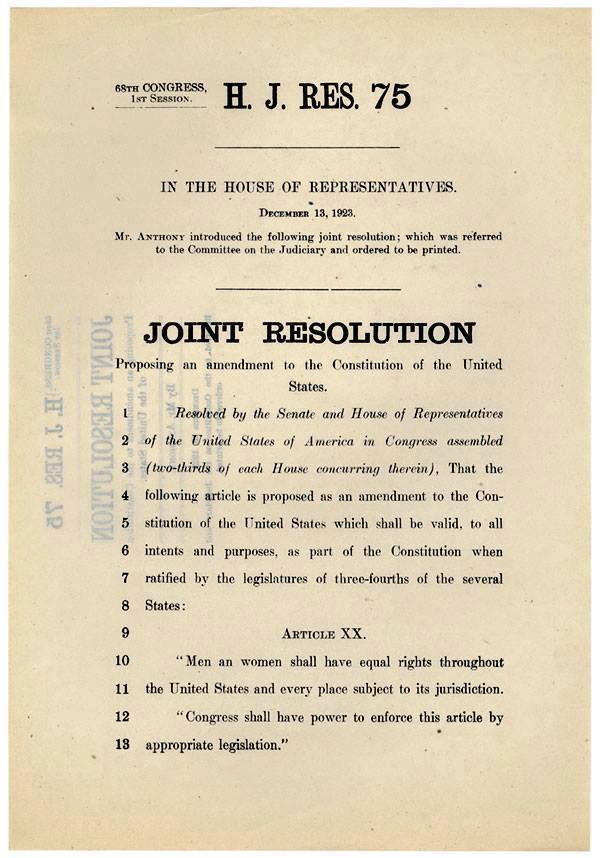
Today in Feminist History is our daily recap of the major milestones and minor advancements that shaped women’s history in the U.S.—from suffrage to Shirley Chisholm and beyond. These posts were written by, and are presented in homage to, our late staff historian and archivist, David Dismore.
December 13, 1923: The fast-paced campaign to amend the Constitution to ban all forms of sex discrimination achieved another milestone today.
After having been introduced into the Senate on December 10th, an Equal Rights Amendment has now been introduced into the House as well. Though the National Woman’s Party’s formal campaign for the legislation has been underway for less than five months, the proposed amendment has sponsors in both Houses of Congress, and hearings are expected soon.

It was only 40 months ago that the 19th Amendment was ratified, and veterans of that struggle had to decide what to do now that sex discrimination in regard to voting rights had been banned nationwide.
On the day Tennessee became the 36th and final State needed to ratify the suffrage amendment, Alice Paul noted that despite that landmark victory, the struggle was far from over: “With their power to vote achieved, women still have before them the task of supplementing political equality with equality in all other fields.“ At its first post-suffrage convention, on February 21, 1921, the National Woman’s Party pledged that “absolute equality” would be its next goal, and legislation that would transform this principle into the law of the land should be drawn up, formally endorsed and submitted to Congress.
In July of this year, party members gathered in Seneca Falls, New York, to celebrate the 75th anniversary of the first women’s rights convention, held there in 1848. On July 21st, the convention delegates enthusiastically adopted a resolution by Alice Paul.
Whereas, only one point in the equal rights program of 1848, that of equal suffrage, has been completely attained; and
Whereas the National Woman’s Party, as stated in its declaration of principles, is dedicated to the same equal rights program as that adopted on this spot seventy-five years ago, be it
Resolved, that in order to bring the complete equal rights ideal to the victory that was won for suffrage we undertake the following program: The securing of an amendment to the United States Constitution stating, ‘Men and women shall have equal rights throughout the United States and every place subject to its jurisdiction.’
Paul also said at that time: “We are not safe until we have equality guaranteed by the Federal Constitution.” She explained that the reason Section One consists of just 18 words is so that: “Everybody must be for it or against it. No politician can get around it by saying he is for it in principle but is against a certain word in the tenth paragraph.” (Section Two is even shorter, and states: “Congress shall have the power to enforce this article by appropriate legislation.”)
Last year, even before this new campaign was officially kicked off, Alice Paul was already demanding that those running for office in the 1922 elections take a stand on equality for women:
Women voters are demanding that the suffrage victory be carried to its logical fulfillment in the granting to women of complete political, legal and civil equality with men. Candidates who wish to appeal to the woman voter will adopt such a plank in their platform. The Woman’s Party intends to make this issue a paramount political issue just as it made suffrage a political issue of prime importance in previous elections.
The form of the campaign pledge requested from State conventions and from candidates is modeled on that made by Lloyd George in the election of 1918, the first election following the granting of suffrage to the women of England. Lloyd George appealed to the women voters of his country on the following plank: ‘It will be the duty of the new Administration to remove all existing inequalities of the law between men and women.’
The suffrage amendment ratified late in 1920 gave the vote to women too late to make their influence decisive in the election of that year. The woman voter has since then informed herself of the far-reaching discriminations still existing against her in the laws relating to office-holding, jury service, property rights, guardianship of children and in other respects. She demands the establishment of a single legal standard for men and women as the fulfillment of the spirit of the suffrage amendment. This is an issue based on justice and political expediency. Women will judge the sincerity and the political wisdom of candidates who appeal for their votes on their stand on this question.
Representative Daniel Read Anthony, Jr., a nephew of Susan B. Anthony, introduced the Equal Rights Amendment (H.J.R. 75) into the House of Representatives today. Another Kansas Republican, Senator Charles Curtis, introduced the companion resolution (S.J.R. 21) into the Senate three days ago. Now comes the task of getting two-thirds of both Houses of Congress to approve it, and three-quarters of state legislatures to ratify what has been nicknamed the “Lucretia Mott Amendment,” after the pioneer feminist.
Since it took so many generations of work and sacrifice to get a Constitutional ban on just one form of discrimination against women—bias in regard to the right to vote—the battle for “absolute equality” could be a long one. But thanks to the efforts of those who won that first fight, the tool women need to achieve Constitutional equality is available. Once the votes of women who believe in total equality are combined with those of men who also support such a goal, and are used to defeat lawmakers who would stand in the way of equal rights, this new amendment will be ratified as well, and the date of its inclusion into the Constitution will be celebrated annually—just as the 19th Amendment’s final victory on August 26, 1920 is now.





